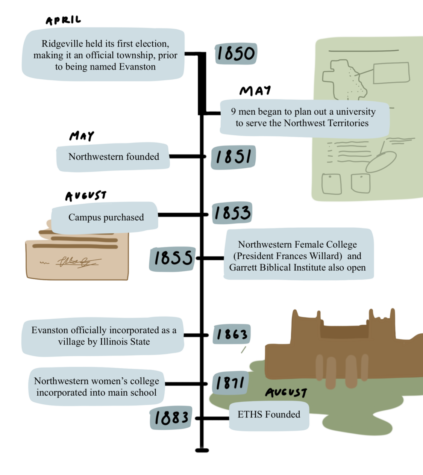Your donation will support the student journalists of the Evanstonian. We are planning a big trip to the Journalism Educators Association conference in Philadelphia in November 2023, and any support will go towards making that trip a reality. Contributions will appear as a charge from SNOSite. Donations are NOT tax-deductible.
Formative years of Northwestern led to the founding, growth of Evanston
January 28, 2022
Evanston and Northwestern University’s history is so entangled and intertwined, it is easy to forget which was the predecessor.
However, Northwestern has asserted its dominance and control of the North Shore for nearly 200 years, shaping the cultural and intellectual framework of its surrounding city.
Northwestern came first. The founding of the school was in January of 1851, by founders such as John Evans and Orrington Lunt. These names sound familiar to any Evanston resident, largely due to their appearance throughout the city; Evans is the namesake of Evanston, and Lunt has streets, parks and an elementary school dedicated to him. The university settled in its current coastline home, and, in 1853, the founding members of the school officially purchased the 379-acre property. This purchase occurred prior to the establishment of Evanston, which didn’t happen until 1863.
Evanston and Northwestern’s history intersects and overlaps numerous times, often with the two entities at odds with each other. Yet, there has always been partnership and connection, especially when it comes to education and civil movements.
“Northwestern University was founded by Methodists. So that’s where that political outlook really comes from. Northwestern and Garrett Seminary, and then the small women’s college established the tone of education being important in the early years, the 1850s. That really made the people who moved to Evanston make it this place where education is valued, and [where there is] the importance of church-going and moral reform movements. All of it kind of sets this tone, and that tone stays with us through all of these years,” Lori Osborne, the director of the Evanston Women’s History Project (EWHP) and a historian at the Evanston History Center (EHC), says. “It’s not a coincidence as citizens of a place where we’re grappling with issues around race and reparations. It doesn’t surprise me having seen what was happening in those early founding years.”
Northwestern historian and archivist Kevin Leonard elaborates on Northwestern’s origins, specifically the purpose of the university.
“Northwestern was founded through the efforts of nine transplants to the city of Chicago, all professing membership in what was then known as the Methodist Episcopal Church. We know that denomination today by its modern name of the United Methodist Church. In 1851, the year Northwestern was founded, Chicago was a city of about 30,000 people, which is small by our appreciation of Metropolitan Chicago today. But at the time, it was a fairly significantly sized community, and more importantly, growing rapidly,” Leonard says. “So the nine founders of Northwestern decided that Chicago was a growing concern. They certainly were involved in making their own marks on the city and in various professional fields. But they thought that the city would grow [and] that there was a future to the city of Chicago and the Chicago region. Like people of other religious backgrounds, they wanted to establish an institution of higher education affiliated with their denomination.”
The key founders of Northwestern had a united mission of establishing a school under Methodist principles and ideas that catered to the growing Midwest region.
“Most American colleges and universities established prior to the 20th century were allied with religious denominations, so this was an opportunity for the Methodists in this community to plant their flag, at least in the realm of higher education, and have a flagship institution,” Leonard explains. “They received a charter from the state legislature of Illinois in 1851. If you look at Northwestern’s formal seal, it’s [from] 1851, [which is] when Northwestern came out as a legal corporate entity. It took several years for them to raise the money to acquire land, build a building and hire faculty. Northwestern didn’t open its doors to students until November of 1855. So between 1850 and 1855, there [were] a couple of projects that the founders had to embark upon. One was selecting a location.”

When choosing a site for the university, the founders were drawn to the North Shore, a fairly underdeveloped area at the time dedicated primarily to trade along the Green Bay Trail.
Established in large measure by the founders of Northwestern University, [they] acquired so much of the land in this area and planted it and made it available for sale largely from these. It came through the appeal of this community, to the appeal of this area to like-minded settlers. Northwestern, early on, amended its charter from the state of Illinois to include a four-mile limit on the sale of alcohol from the university. So there was a line drawn [which] prohibited alcohol within that radius. And that meant for people who abstained from consuming liquor or people of like mind who didn’t appreciate liquor that this would be a salubrious, healthy community for people who have similar interests. So one of the key social planks in the Methodist platform was abstinence from alcohol,” Leonard says.
Furthermore, Osborne connects the mission of the various components of Northwestern to early reform movements occurring in Evanston during its formative years. Most notably, the efforts of Frances Willard, a prominent figure in the temperance movement, formed the Christian Women’s Temperance Union, an international organization that was headquartered in Evanston.
“[Willard] becomes the Dean of Women when Northwestern becomes co-educational [in 1871] and goes on to found the largest women’s organization in the world,” Osborne adds. “No one in Evanston thinks it’s unusual that the most famous person in their town is a woman. And she’s a reformer. This is just the way this community was built.”
In the early years, as Osborne and Leonard express, Northwestern instituted a set of moral values which created the foundation for Evanston, but Evanston was not the first town to utilize this land. Previously, there had been settlers and Native tribes. According to the Mitchell Museum of the American Indian, Evanston’s location was previously the land of the Ho-Chunk, Ottawa, Miami and Potawatomi tribes.
Then, in 1832, the Green Bay Trail was established as a connection between Chicago, Ill. and Green Bay, Wis., resulting in the formation of small villages along the trail, such as Ridgeville, which stood where Evanston is today. The name Ridgeville first appeared in 1851, almost simultaneously with the establishment of Northwestern, primarily due to their similar reasons of origins.
During the mid-19th century, a wave of people coming from Chicago began to settle in what would be known as the North Shore. Both the settlers of Ridgeville and the founders of the university saw the opportunity in purchasing large tracts of this land and modeling the community they desired.
The Ridgeville Park District, a private district located in Evanston dedicated to preserving the history and land of Ridgeville, states on its webpage that “In 1857, the General Assembly of Illinois, by special act, provided that the Township of Evanston consist of all of Township 41, Range 14 (Ridgeville) and one mile out of Township 41, Range 13 (Niles). The land that would become the City of Evanston was purchased from Dr. John Foster by a group of Methodist businessmen for a university.”
“There had been people living in this area prior to Northwestern, in a town [that] was not known as Evanston. The point of the name came in recognition of John Evans, the leader among Northwestern founders, and in recognition of the place that Northwestern sat, as Northwestern University has been the leading institution of this area. So they named [the area] Evanston,” Leonard says in response to the shift from Ridgeville to Evanston.
The switch from Ridgeville to Evanston was a transition spanning over decades. The Ridgeville Park District shares that there is historical confusion on when Ridgeville was officially tied into Evanston because of civil disputes.
“There is evidence that, as late as 1902, residents of the area known as Ridgeville still considered themselves Ridgeville residents and considered Evanston to be the land purchased by Northwestern University,” the Ridgeville Park District website states.
This misconception may be rooted in the integral role of Northwestern in forming Evanston. Funding and population were key ways the university reared the town into the domestic haven the founders desired, primarily through overseeing the establishment of religious institutions and schools.
“Northwestern influenced the character of the community beyond just being an educational institution, and the chief educational institution, in the region, influencing the composition of that community in that other manner. Now, it’s not to say that people who founded Northwestern had issues with the foreigners and people of other denominations. But overriding that was this four-mile limit, and that gave him arguably a more wholesome character to what we call Evanston,” Leonard outlines.
Northwestern’s influence runs deep in Evanston and, as Leonard states, Northwestern is responsible for the creation of the city and township currently in existence and the residents it historically attracts.
“The city of Evanston, we’re overall a highly educated city. We have Northwestern University here, which, of course, attracts a lot of highly educated [people] and folks who are on their way to becoming highly educated folks to our town. And, so, that is a benefit. Education is a key part of the identity of the City of Evanston,” says Eighth Ward alderman Devon Reid.
Northwestern’s formative years laid the groundwork for the city surrounding the internationally renowned research institution. However grateful Evanstonians may be for the resources, ideas and influence the university has shared with the city, there has been a fair share of conflict and tension.
